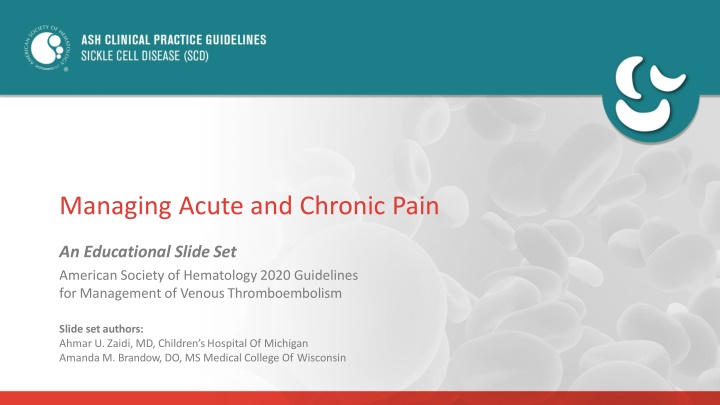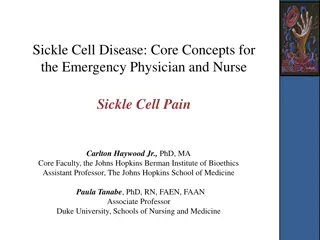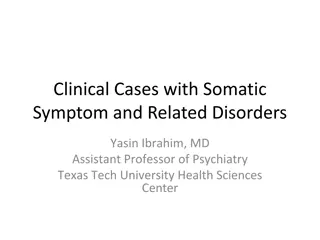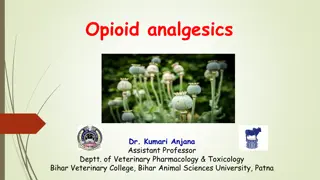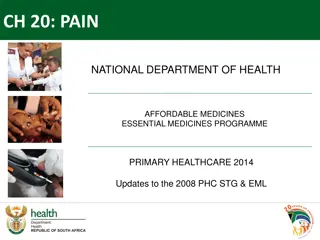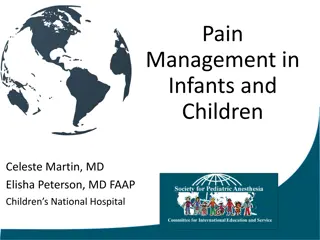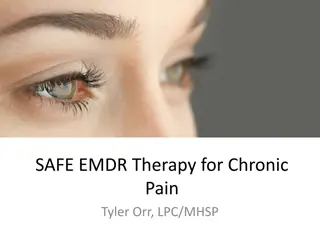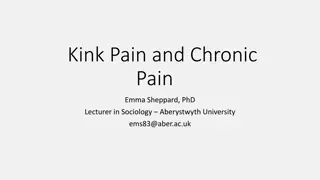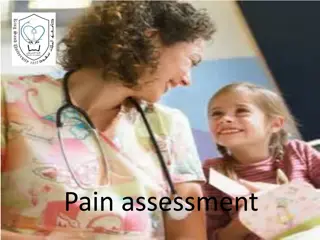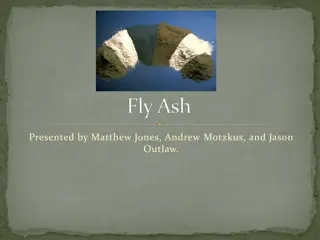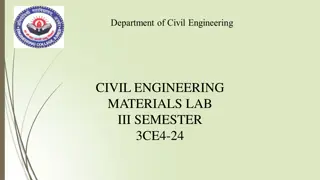Managing Acute and Chronic Pain - ASH Guidelines 2020
This presentation discusses the management of acute and chronic pain in sickle cell disease based on the American Society of Hematology (ASH) guidelines for 2020. The guidelines cover various aspects such as panel formation, evidence synthesis, making recommendations, clinical questions, and how to use the recommendations effectively. The content emphasizes patient-centered care, evidence-based practices, and the importance of shared decision-making in treatment approaches.
Download Presentation

Please find below an Image/Link to download the presentation.
The content on the website is provided AS IS for your information and personal use only. It may not be sold, licensed, or shared on other websites without obtaining consent from the author.If you encounter any issues during the download, it is possible that the publisher has removed the file from their server.
You are allowed to download the files provided on this website for personal or commercial use, subject to the condition that they are used lawfully. All files are the property of their respective owners.
The content on the website is provided AS IS for your information and personal use only. It may not be sold, licensed, or shared on other websites without obtaining consent from the author.
E N D
Presentation Transcript
Managing Acute and Chronic Pain An Educational SlideSet American Society of Hematology 2020 Guidelines for Management of Venous Thromboembolism Slide setauthors: Ahmar U. Zaidi, MD, Children s Hospital Of Michigan Amanda M. Brandow, DO, MS Medical College Of Wisconsin
ClinicalGuidelines American Society of Hematology 2020 guidelines for sickle cell disease: management of acute and chronicpain Amanda M. Brandow, C. Patrick Carroll, Susan Creary, Ronisha Edwards-Elliott, Jeffrey Glassberg, Robert W. Hurley, Abdullah Kutlar, Mohamed Seisa, Jennifer Stinson, John J. Strouse, Fouza Yusuf, William Zempsky, and Eddy Lang https://doi.org/10.1182/bloodadvances.2020001851
ASH Clinical Practice Guidelines on SCD 1. Cardiopulmonary and KidneyDisease 2. TransfusionSupport 3. CerebrovascularDisease 4. Acute and ChronicPain 5. Stem CellTransplantation
How were these ASH guidelines developed? PANEL FORMATION Each guideline was formed following these keycriteria: Balance (including beyond andpatients) Close attention to minimization and management of conflicts of interest EVIDENCESYNTHESIS Evidence summary generated for each PICO question via systematic review of health effects plus: Resource use Feasibility Acceptability Equity Patient valuesand preferences MAKING RECOMMENDATIONS Recommendations made by guideline panel membersbased on evidence for all factors. CLINICALQUESTIONS 10 clinically-relevant questions generated in PICO format (population, intervention, comparison, outcome) panel of expertise disciplines hematology, Example: PICO question Should automated red cell exchange vs simple transfusion or manual red cell exchange be used for patients with SCD receiving chronic transfusions? ASH guidelines are reviewed annually by expert work groups convened by ASH. Resources, such as this slide set, derived from guidelines that require updating are removed from the ASH website.
How to use these recommendations STRONG Recommendation ( The panel recommends ) CONDITIONALRecommendation ( The panel suggests ) Most individuals would want the intervention. A majority would want the intervention, but many would not. Forpatients Different choices will be appropriate for different patients, depending on their values and preferences. Use shared decisionmaking. Most individuals should receive the intervention. Forclinicians
Good PracticeStatements It is good practice to provide patient-centered education and surveillance related to NSAID toxicity, especially in patients with end-organ comorbidities, because long- term safety data are lacking for SCD, but vascular, bleeding, and renal risks may be elevated. Given the prevalence of psychological comorbidities that are present in the context of pain, it is good practice to routinely screen for depression and anxiety and to perform targeted screening for other psychological comorbidities.
Objectives To understand non-opioid pharmacologic therapy for acute pain and non-opioid pharmacological therapies either in addition to or instead of opioids or other usual care interventions for the treatment of acute pain in children and adults with SCD. To understand non-pharmacologic therapies for acute pain and if nonpharmacological therapies in addition to pharmacological therapies should be used for the treatment of acute pain in children and adults withSCD. To understand non-opioid pharmacologic therapy for chronic pain and if non-opioid pharmacological therapy should be used for children and adults with SCD and chronic pain with no identifiable cause beyondSCD. To understand non-pharmacologic therapy for chronic pain and if nonpharmacological therapies be used in addition to pharmacological therapies be used for the treatment of chronic pain in children and adults withSCD.
Abnormalities in peripheral nerves, brain and spinal cord initiate, transmit and sustain pain signals resulting in complex, pathologicalpain
Treating all pain the same is like treating all forms of anemia with sameapproach Need to determine etiology ofpain
negativeprovider attitudes stigma environmental stressors traumatic lifeevents disparities incare Sociological hematologicalfactors inflammation nervoussystem sensitization chronic organdamage Biological Acute and ChronicPain depression anxiety learnedhelplessness sleepdisorders Psychological adapted from Brandow AM, DeBaun MR. Hematol Oncol Clin North Am.2018
Hematologist and PrimaryCare Provider
Clinical scope of guideline panel questions Acute Pain (5questions) Delivery of analgesia (location and protocol) Role of non-opioid pharmacologic therapy Role of non-pharmacologic therapy Chronic Pain (5questions) Role of non-opioid pharmacologic therapy Role of non-pharmacologic therapy Using chronic opioid therapy Using chronic transfusion therapy
SCD Pain Guidelines Timeline Panel met in person second time to draft recs November 2018 Panelmet in person to draft PICO questions June2017 Panel met in personto develop draft recs April2018 Guidelines published in Blood Advances June2020 Chair and Co-chair appointed Aug2016 All public Comments reviewed Methods team conducted literature searchesJuly 2017-March 2018 Finalrecs approved by Guideline Oversight Committeeand ASH Executive Committee February2020 All Methodsteam conducted additional literature searches Public comment periodApril through May2019 panelists appointed March 2017
Composition of Panel Hematology Painmedicine Nursing Psychology/psychiatry Emergencymedicine Patient and parent of young adult withSCD Methodologist (GRADE workinggroup) *Pediatric and adult providers
Datasources Directevidence Minimalavailable Indirectevidence Pain conditions other than SCD Enrich evidence on which to base guidelines Mayo Clinic Evidence Based Practice ResearchCenter Conducted and assimilated systematic evidence reviews
Indirectevidence Consensus reached via independent online survey and panel discussion about: Questions to be addressed by indirect evidence Pain conditions that most closely parallel acute and chronic SCD pain Based on similarities to the biology or experience of individuals with SCD Searched for systematic reviews/meta-analyses Must include 5 studies Single studies not used Evidence downgraded as per GRADE for population indirectness
Major Challenges in Guideline Development Lack of direct evidence Minimal (if any) high quality evidence Lack of randomized-controlled trials Harnessing indirect data Differentiating acute and chronic pain in literature Pediatric and adult data not always available in parallel
Overview of pain guielines SCD Pain ChronicPain -Identifiable cause -Non-identifiable cause beyond SCD Acute Pain Analgesic delivery (location/protocol) (3) Non-opioid pharmacologic therapy(4)* Non-opioid pharmacologic therapy(5)* Chronicopioid therapy(3) Chronictransfusion therapy(1) Non-pharmacologic therapy(1) Non-pharmacologic therapy(2)* Chronictransfusion therapy(NR) *Recommendations that utilized indirect evidence; NR: NoRecommendation
SelectedGuidelines in this Presentation non-opioid pharmacologic therapy for acute pain non-pharmacologic therapy for acute pain non-opioid pharmacologic therapy for chronic pain non-pharmacologic therapies for chronic pain chronic opioid therapy for chronic pain
NON-OPIOID PHARMACOLOGIC THERAPY FOR ACUTE PAIN
Should non-opioid pharmacological therapies either in addition to or instead of opioids or other usual care interventions be used for the treatment of acute pain in children and adults withSCD?
Opioids have been the mainstay for the treatment of acute pain related to SCD Some patients do not respond to opioid therapy alone the tenets of appropriate management of acute pain include multimodal analgesia Pathways to reduce the opioid burden would provide nonopioid analgesics to treat acute pain with the goal of reducing the total dose and duration of exposure while maintaining or improvinganalgesia There has been a greater understanding of the complex nature of pain in SCD such that better definitions of acute pain, chronic pain, and acute-on-chronic pain have emerged
Non-opioid pharmacologic interventions for acute pain refractory to opioids Recommendation 2c. For adults and children presenting with acute pain related to SCD who are hospitalized, the ASH guideline panel suggests a sub-anesthetic (analgesic) ketamine infusion as adjunctive treatment for pain that is refractory or not effectively treated with opioids alone (conditional recommendation based on very low certainty in the evidence about effects ). Remarks: 1. This recommendation assumes safe administration of sub-anesthetic ketamine infusions in the hospital inpatient unit in centers that have appropriate expertise to administer the drug. 2. Recommended dose for sub-anesthetic (analgesic) infusion for acute exacerbation of SCD pain starts at 0.1 to 0.3 mg/kg/h with a maximum of 1mg/kg/h. 3. Currently, there is no standardized, widely accepted definition for the word refractory ; thus, whether pain is considered refractory is determined at the clinician s discretion.
Subanesthetic ketamine for treatment of acute pain The balance of effects favors the intervention Subanesthetic ketamine should be used cautiously in this population and in patients for whom first-line treatment (ie, opioids) has failed or in patients who wish to avoid opioidanalgesia Because of the absence of high-quality data and overall low to moderate certainty in the evidence about effects, the recommendation is conditional
Acute pain refractory to opioid therapy: Non-opioid pharmacologic interventions Recommendation 2d. For adults and children presenting with acute pain related to SCD, the ASH guideline panel suggests regional anesthesia treatment approaches for localized pain that is refractory or not effectively treated with opioids alone (conditional recommendation based on very low certainty in the evidence about effects ). Remarks: 1. Regional anesthesia in this context is defined as epidural or peripheral nerve catheter-delivered analgesia for abdominal, hip or legpain. 2. The procedure needs to be technically feasible based on the anatomic location of the pain. 3. A thorough explanation of the procedure as well as risks, benefits and alternative options should be provided to patients and families prior to the procedure. 4. The recommendation assumes administration of procedure in a center that has appropriate resources and expertise. 5. There is considerable uncertainty around optimal timing and indications for regional anesthesia interventions; however, the panel emphasized the importance of shared decision-making based on the patient s knowledge of their own disease and course of pain-related complications and strategies that promote reduced opioid requirements, improved function, pain management and reduced duration of hospitalization.
Regional anesthesia for treatment of acute pain The balance of effects favors the intervention The absence of high-quality data for patients with SCD, regional anesthesia should be used only in centers with the appropriate expertise, in inpatients with: localized pain that is amenable to a regional approach or in patients for whom first-line treatment (ie, opioids) has failed or those who wish to avoid opioid analgesia
NON-PHARMACOLOGIC THERAPIES FOR ACUTE PAIN
Should nonpharmacological therapies in addition to pharmacological therapies be used for the treatment of acute pain in children and adults withSCD?
Non-pharmacological therapies for acute pain The first line of treatment of SCD pain is pharmacological therapies, such as NSAIDs and opioids, but may not always beenough Nonpharmacological interventions have the potential to ease pain and reduce the need for opioids or other pharmacologicaltreatments massage, yoga, transcutaneous electrical nerve stimulation (TENS), Virtual Reality (VR), guided audiovisual (AV) relaxation, acupuncture, biofeedback, mindfulness, spirituality, cognitive behavioral therapy (CBT), meditation Panel examined impact of nonpharmacological therapies on patient-centered outcomes improved pain intensity, pain coping strategies, and health related quality of life, reduction in total opioid consumption, length of stay, and return to baseline pain
Non-pharmacologic therapy for acute pain Recommendation 3. For adults and children who seek treatment for acute pain, the ASH guideline panel suggests massage, yoga, transcutaneous electrical nerve stimulation (TENS), virtual reality (VR) and guided audiovisual (AV) relaxation in addition to standard pharmacological management (conditional recommendation based on very low certainty in the evidence about effects ). Remarks: 1. This recommendation is based on direct evidence from patients with SCD and indirect evidence largely from postoperative adult mixed surgicalpopulations. 2. Despite the evidence primarily based on adult populations, there is low risk of harm in children. However, a tailored approach should be used that matches feasibility and acceptability for a given patient. Some interventions may not apply to younger children; thus, the age of the patient should be considered, especially for interventions such as yoga and guided AV relaxation. 3. Time requirements, financial costs, availability and training of therapists for these types of treatments are important factors in treatment selection and should be discussed with patients in the course of shared decision-making.
NON-OPIOID PHARMACOLOGIC THERAPY FOR CHRONIC PAIN
Should non-opioid pharmacological therapy, either in addition to or instead of opioids or other usual care interventions, be used for children and adults with SCD and chronic pain with no identifiable cause beyond SCD?
Individuals living with SCD experience chronicpain The prevalence of chronic pain increases with age and may not be associated with an identifiablecause Chronic pain in individuals with SCD is often treated with opioid and nonopioid analgesicmedications There is a lack of evidence-based guidelines comparing chronic nonopioid therapy with chronic opioid therapy for chronic SCDpain
Non-opioid pharmacologic therapy for chronic pain Recommendation 7a. For adults who have SCD-related chronic pain with no identifiable cause beyond SCD, the ASH guideline panel suggests SNRIs (e.g., duloxetine and milnacipran) as options for pain management (conditional recommendation based on very low certainty in the evidence about effects ). Remarks: 1. This recommendation is based largely on indirect evidence from adult patients without SCD affected with fibromyalgia. Fibromyalgia was selected by panel consensus as the entity most closely aligned with chronic pain in SCD (with no identifiable cause beyond SCD). 2. Antidepressants may increase the risk of suicidal ideation and behavior in children and adolescents with major depression disorder and other psychiatric disorders. 3. The significant lack of pediatric data for the use of SNRIs for pain management could not support a recommendation for this age group.
Non-opioid pharmacologic therapy for chronic pain Recommendation 7b. For adults who have SCD-related chronic pain with no identifiable cause beyond SCD, the ASH guideline panel suggests tricyclic antidepressants (e.g., amitriptyline) as an option for pain management (conditional recommendation based on very low certainty in the evidence about effects ). Remarks: 1. This recommendation is based largely on indirect evidence from adult patients without SCD affected with fibromyalgia. Fibromyalgia was selected by panel consensus as the entity most closely aligned with chronic pain in SCD with no identifiable cause. 2. Antidepressants may increase the risk of suicidal ideation and behavior in children and adolescents with major depression disorder and other psychiatric disorders. 3. The significant lack of pediatric data for the use of tricyclic antidepressants for pain management could not support a recommendation for this age group. 4. The increased side effect profile for this drug includes, but is not limited to, prolonged QT, orthostasis, cognitive impairment, dry mouth, and anticholinergic effects. These side effects should be considered and discussed with patients.
Non-opioid pharmacologic therapy for chronic pain Recommendation 7c. For adults who have SCD-related chronic pain with no identifiable cause beyond SCD, the ASH guideline panel suggests gabapentinoids (e.g., pregabalin) as options for pain management (conditional recommendation based on very low certainty in the evidence about effects ). Remarks: 1. This recommendation is based largely on indirect evidence from adult patients without SCD affected with fibromyalgia. Fibromyalgia was selected by panel consensus as the entity most closely aligned with chronic pain in SCD with no identifiable cause. 2. The significant lack of pediatric data for the use of gabapentinoids for pain management could not support a recommendation for this agegroup.
An individualized treatment approach is required for the management of chronic pain Considering the available indirect data and the lack of direct data, the decision to initiate and continue chronic nonopioid therapy for chronic SCD pain without an identifiable cause beyond SCD should be individualized. Management should be based on a balance of benefits for that individual patient, harms, risk assessment, and shared decision making between the patient and provider.
NON-PHARMACOLOGIC THERAPY FOR CHRONIC PAIN
Should nonpharmacological therapies be used in addition to pharmacological therapies be used for the treatment of chronic pain in children and adults withSCD?
Many children and adults with SCD also experience ongoing chronic pain The first line of treatment of SCD pain is standard medicaltherapy Pharmacotherapy alone has limited effectiveness in reducing the burden of chronic pain and associated psychosocial co-morbidities that commonly occur with chronic pain Nonpharmacological strategies include psychological techniques (CBT, mindfulness, ACT, coping skills training), physical therapies (e.g., exercise, physical activities, yoga), and integrative medicine approaches (e.g., massage, acupuncture, complementary and alternative therapies), which are being used by patients with SCD
Treatment of Chronic Pain: Non-pharmacologic or Integrative Health Interventions Recommendation 8a. For adults and children with SCD who have chronic pain related to SCD, the ASH guideline panel suggests cognitive and behavioral pain management strategies in the context of a comprehensive disease and pain management plan (conditional recommendation based on very low certainty in the evidence about effects ). Remarks: 1. The cognitive or behavioral pain management strategy with the broadest evidence base is cognitive behavioral therapy (CBT). Other strategies considered by the panel with lower certainty evidence include acceptance and commitment therapy (ACT), mindfulness-based treatments, coping skills training and operanttherapy. This recommendation is based mainly on indirect evidence. The treatments that have been tested in SCD are in children with acute pain without establishing the presence of chronic pain or the intervention s effects on chronic pain. The outcomes assessed in SCD have not typically included pain intensity. The greater body of indirect evidence was drawn from the literature on individuals with fibromyalgia and nonspecific low back pain. No standardized, manualized universally accepted version of CBT is available for SCD in either adults or children. This is a significant clinical and translational research need. Nonetheless, such strategies have shown broad applicability in pediatric and adult chronic non-cancer pain. Interventions based on CBT, coping skills training and guided imagery have some evidence base for SCD, though mainly in children and for episodicpain. In other conditions, these methods are believed to have low risks and are portable in that patients can utilize the skills learned on their own after treatment, possibly with intermittent "booster"sessions. Time, financial costs, availability and training of therapists (i.e., in chronic pain and SCD) and patient burden can be barriers to these types of psychological treatments that are beingrecommended. Cognitive and behavioral pain management strategies should be used in conjunction with other modalities as part of a comprehensive and multimodal pain managementplan. Behavior and cognitive strategies are optimal in a setting where patient is motivated and there is access to appropriately trainedpersonnel. 2. 3. 4. 5. 6. 7. 8.
Treatment of Chronic Pain: Non-pharmacologic or Integrative Health Interventions Balance of benefits vs harms likely favors this intervention. There are few undesirable effects of the intervention except for the time commitment and cost of thesetherapies.
Should chronic opioid therapy versus no chronic opioid therapy or periodic opioid therapy be used in patients with SCD who have chronicpain?
Chronic opioid therapy: General comments Individualized approach to initiating or discontinuing COT: Based on balance between risks/harms and benefits Consider functional outcomes and durability of benefit over time Recommendations are divided based on 3 distinct patient populations Clear presence of chronic rather than episodic pain
Chronic Opioid Therapy (COT) Recommendation 9a. For adults and children with SCD and emerging and/or recently developed chronic pain, the ASH guideline panel suggests against the initiation of COT unless pain is refractory to multiple other treatment modalities (conditional recommendation based on very low certainty in the evidence about effects ). Recommendation 9b. For adults and children with chronic pain from SCD who are receiving COT, are functioning well and have perceived benefit, the ASH guideline panel suggests shared decision-making for continuation of COT (conditional recommendation based on very low certainty in the evidence about effects ). Recommendation 9c. For adults and children with chronic pain from SCD who are receiving COT, are functioning poorly or are at high risk for aberrant opioid use or toxicity, the ASH guideline panel suggests against continuation of COT (conditional recommendation based on very low certainty in the evidence about effects ). *See important Remarks in full guideline manuscript
Remarks Optimization of SCD management is a priority. In those whose pain has been refractory to multiple other interventions, COT should be considered after risk stratification using a validated tool, based on how well patients SCD is managed, comprehensive assessment of behavioral risks (eg, risk factors for opioid misuse), implications of tolerance on the management of acute pain episodes, and other known adverse effects of opioids. Adverse events noted in other non-SCD patient populations are dose dependent and include increased risk of poor surgical outcomes, increased risk of motor vehicle collisions, myocardial infarction, bone fracture, and mortality. Patients on doses of >120 mg of morphine milligram equivalents (MME) are at risk for hormonal alterations, which can lead to sexual dysfunction. Doses >100 mg of MME are associated with a ninefold increase in risk of overdose compared with doses <20 mg of MME in general non-SCD pain populations. Failure criteria for a trial of COT should be discussed in the shared decision-making process, and alternative treatments in the case of failure and a plan for opioid cessation should be developed before initiation. Documentation of this discussion and the goals of care should be included in the medicalrecord. The lowest effective opioid dose should be prescribed. Patients on COT should avoid the use of benzodiazepines, sedating medications, and alcohol. Providers should be aware that patients may inadvertently end up on COT if episodic pain is frequent enough that patients are receiving frequent opioid treatment of recurrent pain. Therefore, providers should make efforts to reduce or eliminate scheduled opioid doses between acute episodic pain events, which may reduce the likelihood of unintentional COT.
FurtherRemarks Optimization of SCD management is a priority. The benefit of COT in SCD is largely unknown, and the harms are established via indirect evidence (recommendation 9a, remark 2); therefore, shared decision making is essential and may lead to continuation once risks of COT and tapering are explained. Function should be assessed from the shared patient/clinician perspective. The use of standardized patient-reported outcome tools that assess patient functioning is encouraged. COT is discussed as a class of drugs. Individual opioid drugs have different specific toxicity profiles and interactions with end-organ injury. Therefore, a review of the individual profile of each drug under consideration for use should be performed for a given patient. The lowest effective opioid dose should be prescribed. Patients on COT should avoid the use of benzodiazepines, sedating medications, and alcohol. Patients on COT require careful monitoring with regard to functional status and risk assessment for the development of aberrant opioid use and medical, social, behavioral, or psychological complications as a precursor to opioid dose reduction or weaning. The risk of adverse events related to COT rises as the total dose increases. Therefore, patients on high doses of opioids need close monitoring for complications and adverse effects.
FurtherRemarks Optimization of SCD management is a priority. Collaboration with a pain specialist should be strongly considered for additional or alternative pain management strategies. Weaning and/or withdrawal from COT is potentially a higher-risk entity in patients with SCD (ie, risk of triggering vasoocclusive events or other medical complications) and should be done carefully. The other recommendations provided in this summary should be used for potential alternatives that could be part of a comprehensive pain management plan. Patients on COT should avoid the use of benzodiazepines, sedating medications, and alcohol. Acute pain events may still be treated with opioid analgesia if this serves the overall pain treatment plan, but this should be done in conjunction with the primary outpatient management team. Furthermore, nonopioid medications and integrative therapies should also be offered as outlined in prior recommendations.
Chronic Opioid Therapy (COT) There are insufficient data to determine the efficacy and/or effectiveness of long- term opioid therapy for improving chronic pain and function in individuals living with SCD Indirect evidence in chronic noncancer pain populations is also insufficient to determine long-term efficacy and/or effectiveness and supports risk for harms The decision to initiate, continue, or taper COT should be individualized and based on a balance of benefits and harms
